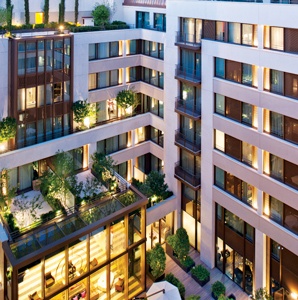 Mandarin Oriental Paris opens its doors.
Mandarin Oriental Paris opens its doors.
On a fashionable stretch of Rue St.-Honoré, between Place Vendôme and the Tuileries, a magic carpet twinkling with fiber-optic lights transports guests from the crowded street to a leafy garden at the heart of a listed Art Deco building. This is the Mandarin Oriental, Paris, which—with 99 rooms and 39 suites—is as thoughtful and polished as one might expect of a five-star hotel with Asian roots. The room-service breakfast menu travels from Paris (a flaky croissant) to New York City (a pastrami sandwich) to Tokyo (miso soup). How many hotel bathrooms come with mirrored vanities at two heights? How many provide not just a blow-dryer but also a flatiron and a clothes steamer? Leaving no stone unturned in terms of amenities is a winning formula; style-wise, the hotel is certainly an aesthetic mix. The sparkly glamour of the entry continues in Bar 8, where the Lalique-crystal-studded walls seem like a spiderweb of glittering dewdrops. Guest rooms veer off in another direction entirely, dipping into the Orient, surrealism—via an abstracted Man Ray photograph printed on velvet headboards—and pure Modernism. The courtyard garden channels Zen, as do the spa (where silverleaf butterflies flit across a white-glass mosaic) and the Camélia restaurant (where giant petal-like structures form the walls). At the Mandarin Oriental, Paris, imagination is alive and the visual cues are numerous; it’s nightclub versus nature preserve, with splashes of haute couture. Still, no matter how eclectic the design, the hotel group’s legendary service remains right on target—in other words, invisible.